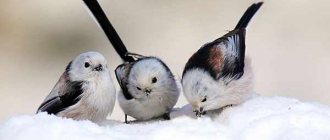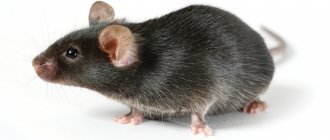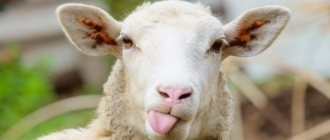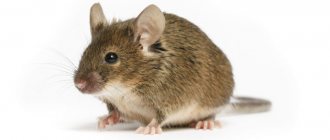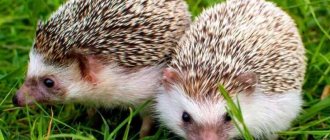African animals, hippos, continue to amaze researchers to this day. No other living creature on Earth is like them, these unpredictable giants who spend half their lives in water. Curious tourists from all over the world come on safari to Africa to see these amazing creatures with their own eyes, despite all the difficulties associated with it.
- They are also called hippopotamuses, and both names are considered correct.
- The weight of an adult hippopotamus can exceed 4 tons.
- Oddly enough, scientists believe that the closest biological relatives of hippos are whales.
- The first written mentions of hippopotamuses were made approximately 2.5 thousand years ago by the Romans.
- Even crocodiles are afraid of these animals - an adult hippopotamus is able to bite this reptile in half (interesting facts about crocodiles).
- When diving under water, special valves in the nostrils of hippopotamuses block water from entering their nose, so they do not snort when floating back to the surface.
- They can hold their breath for 3-5 minutes while diving under water.
- Hippos live only in fresh water. Some researchers have also seen them in the seas, near river mouths, but in such conditions these animals usually do not linger.
- They have very sensitive hearing, and they hear well both under water and on land.
- Hippos usually spend most of the day in the water, emerging on land at dusk.
- Sometimes female hippos give birth to their babies in the water rather than on land.
- An adult hippopotamus can open its mouth so wide that the distance between its upper and lower jaws is 1-1.5 meters.
- While on land, their bodies dehydrate faster than any other mammal on Earth.
- During the night, hippos in search of food sometimes walk 10-12 kilometers, or even more.
- Hippos grow and gain weight throughout their lives, which reaches 40 years in the wild and up to 50 in captivity.
- Old hippos sometimes die of starvation after their molars, needed for grinding food, are completely worn down.
- An adult animal consumes 50-60 kilograms of food per day.
- Hippos are indeed quite slow animals, both in water and on land, but over short distances they can run at speeds of up to 30 km/h.
- The skin of these animals is one of the toughest of all living creatures.
- Because of its short legs, a well-fed hippopotamus sometimes touches the ground with its drooping belly.
They are created for aquatic life
Hippos have unique skin that needs to be kept moist for most of the day. Staying away from water for too long can lead to dehydration, so hippos try to stay in the water during the daytime. In addition, being under water helps the hippopotamus not to feel the weight of its clumsy body.
Photo: www.isilimelalodge.com
The body of a hippopotamus is well adapted for an aquatic lifestyle. Its eyes are located on the top of its head, so the hippopotamus can submerge most of its body underwater and still see what is happening above the water. A transparent membrane covers and protects his eyes, allowing him to see perfectly in the water. The nostrils are also located at the top of the snout, so the animal can remain underwater, but still breathe and sniff the air. When a hippopotamus dives, its nostrils close to keep water out.
The ears are located high on the head, so the hippopotamus can hear what is happening above the surface of the water while swimming. But what about sounds underwater? This is the job of the hippopotamus's jaw, which conducts sound waves. Thus, a hippopotamus with its jaw down can hear sounds above and below water at the same time!
And one more way the hippopotamus adapts to life in water: the ability to hold its breath for up to five minutes. They are even able to sleep in the water, using a natural reflex that allows them to jump up, catch their breath and sink back to the bottom without waking up.
What do hippopotamuses eat?
Although these animals live in reservoirs, they do not like aquatic plants, so the basis of the hippopotamus’ diet is herbs and various greens. As soon as the sun sets, hippos come to land and spend the night hours eating succulent plant stems, young shoots of bushes and reeds. An adult hippopotamus requires at least 40 kg of food per day, but with an abundance of green food, it can eat up to 70 kg of grass.
Hippopotamus at the evening meal
Hippopotamuses have a very specific feeding method: they do not chew plants, but grab entire bunches of stems with their fleshy lips, after which they simply swallow them. By the way, hippos eat exclusively terrestrial parts of grasses; their wide muzzle is not adapted to digging up roots and plant tubers.
The hippopotamus menu sometimes includes meat. Surprisingly, these giants can attack antelopes and gazelles in the water, and happily feast on the caught herbivore. Hippos do not disdain carrion, and cases of infanticide have also been observed among them, when adult individuals (mainly males) kill and eat newborn cubs.
Hippos secrete "blood sweat"
Photo: Tim De Pauw
Staying underwater for a long time also helps the hippopotamus stay cool and protect its body from the sun's rays. It has no true sweat glands, so when hippos do leave the water for significant periods of time, they secrete a thick red substance from their pores known as "blood sweat." But don't worry! Bloody sweat creates a layer of mucus that protects the hippo's skin from sunburn and keeps it moist. It is believed that these mucous secretions can also prevent infections; even large wounds do not become inflamed, despite the dirty water in which wild hippos sometimes live.
Nutrition
Previously, it was widely believed that hippos were exclusively herbivores. But this is only partly true. Also, since these animals spend a lot of time in the water, it seems logical to put forward the version that they feed on algae.
But this is absolutely not true. They do indeed feed on plants, but only terrestrial and semi-aquatic ones, and of a wide variety of species and forms. But the aquatic flora, due to the peculiarities of the body of hippopotamuses, does not attract them at all.
Therefore, living giants come out onto land, where they graze in suitable places, jealously guarding their areas and not allowing even relatives to approach them, so that uninvited guests do not interfere with their meal.
Often, with their gluttony, walking heavyweights cause enormous harm to human cultural crops. They trample fields and get into vegetable gardens, mercilessly destroying everything growing there. Their keratinized lips are a wonderful tool, capable of cutting off grass right to the roots, thus mowing down everything around them in a short time.
And they consume up to seven hundred kilograms of such plant food per day. Interestingly, in the process of digesting food, hippos release harmful gases not through the intestines, like most other living organisms, but through the mouth.
But the hippopotamus is herbivore ; at times it turns into a cruel, seasoned predator. More often, only young individuals are capable of such feats. Their huge fangs, self-sharpening against each other, in exceptional cases reaching a meter in length, as well as incisors, are a terrible weapon, which by nature is not at all intended for chewing plant food, but only for killing. And only with age do animal teeth become dull, and their owners become more harmless.
Herbaceous food is not so effective and high in calories, and therefore hippos often include fresh meat in their diet. Driven by hunger, they catch gazelles and antelopes, attack cow herds, even cope with crocodiles, but sometimes they are content with unseemly carrion, thus satisfying the body’s need for minerals.
In search of food, hippopotamuses, as a rule, do not travel long distances from bodies of water, except maybe a couple of kilometers. However, in difficult times, the desire to be satisfied can force the animal to leave the pleasant water element for a long time and embark on a long earthly journey.
Hippos are vegetarians
Hippos prefer a plant-based diet. They require large amounts of energy to live and therefore need rich food sources. If they were carnivores, there would be more competition for food and more energy would be required to obtain food.
At dusk, hippos leave the water and go 5-8 km inland to reach a suitable pasture with short grass, which is their main means of subsistence. They can eat up to 68 kg of grass per night, using their wide mouth like a lawnmower. This amount is up to 1.5% of their weight. By comparison, most cattle eat 2.5% of their body weight every day.
Photo: www.hippoworlds.com
Hippopotamus ears help them hear the sounds of falling fruit, and their keen sense of smell helps them sniff out tasty treats. In zoos, hippos are fed grass pellets, alfalfa, lettuce and mixed vegetables, and on special occasions, melons.
Security status
The population of hippos is constantly declining; currently there are approximately 130 thousand individuals in their habitats. The main reason for the extinction of animals is poachers. Most often, those animals that inhabit unprotected areas suffer.
There are also fewer animals due to habitat loss. Hippos cannot live without freshwater, so they are extremely vulnerable to dry conditions, agricultural activity, industry and changes in the routes of natural water flows. People are taking measures to protect and preserve the natural population of hippos. In countries where there are many animals, hunting is prohibited. The natural habitats of animals are carefully protected.
Hippos are territorial animals
Hippos spend much of the day in slow-moving rivers and lakes in Africa in groups called herds. They contain from 10 to 30 animals. Although there were also much larger groups – up to 200 individuals! In the evenings, the herd breaks up: males leave the water alone, and females leave with their cubs.
In one herd there are young animals, several adult females and males, but there is always one dominant male. He has the right to mate with all the adult females of his herd, although he will sometimes allow other submissive males in and around his territory to mate. The dominant male reminds other hippos of his territory by throwing dung as far as possible with his fan-shaped tail!
When rival males meet, they stand nose to nose with their mouths as open as possible, at an angle of up to 150 degrees! It's called "gaping", a way of appreciating each other. Usually the smaller male will retreat without the larger hippopotamus pursuing him. When two hippos decide to fight, they cut their opponents with their fangs or swing their huge heads like a sledgehammer, while roaring loudly. Some males are killed as a result of very aggressive fighting.
Behavior
Hippos are very social animals, living in groups of 20-100 individuals. They lead a sedentary lifestyle, resting most of the day, and at dusk they leave their pools and go to the pasture. Most activity occurs at night. Females are the leaders of the herd and control the calm in the pools during rest. Males rest along the outer banks of the water, thereby protecting females and cubs. At the age of 7, males begin to compete for dominance. This is expressed by yawning, roaring, splashing manure and clenching the jaws.
Dominant males are very intolerant of young males who challenge them. Adult males tend to severely injure and even kill young males during such fights. Territorial behavior is characterized by wheezing, honking, and dung showers. When approaching new territory, they turn the back of their body towards that location and mark the territory. They swing their tails from side to side and scatter their excrement around unfamiliar terrain. Males often emerge from the water to mark shorelines and grasslands where they feed.
The protection of their territories occurs during the dry period, when living conditions become more saturated and resources are limited. Defensive signs such as yawning, jaw clenching and fang ringing are designed to protect the herd from predators and to threaten other males.
These are one of the most dangerous and aggressive mammals
Despite their cute appearance, hippos are one of the most formidable opponents. Sharp fangs and powerful jaws are the most valuable weapons of a hippopotamus; they can bite a crocodile's spine or split a boat in half. Their fangs and incisors are constantly growing and reach 51 cm in length.
Photo: Chris Stenger
A hippopotamus can kill a human if provoked or if it feels threatened. But the formidable fangs are used mainly for self-defense or to fight other hippos. To ward off enemies or warn potential competitors, the hippopotamus may yawn, scoop water with its mouth, shake its head, rear, lunge, growl, grunt, chase and make a loud wheezing sound.
Scientific classification
- Domain: eukaryotes
- Kingdom: Animals
- Subkingdom: eumetazoans
- No rank: bilaterally symmetrical
- No rank: deuterostomes
- Type: chordates
- Subphylum: vertebrates
- Infratype: gnathostomes
- Superclass: quadrupeds
- Class: mammals
- Subclass: animals
- Infraclass: placental
- Superorder: Laurasiotherium
- Order: artiodactyls
- Superfamily: Hippopotamoidea
- Family: hippopotamuses
- Subfamily: Hippopotaminae
- Genus: hippos
- Species: hippopotamus
Childbirth occurs during the rainy season
The hippo breeding season begins during the dry season, so most births occur during the wettest time of the year. Hippos prefer to breed in water, but can also breed on land. Amazingly, the gestation period for such a large mammal is only 8 months - slightly less than the human gestation period - but a baby hippopotamus is about 10 times larger than a human baby!
When the female approaches her time to give birth, she will leave the herd for one or two weeks to give birth to and bond with one young. If the baby is born underwater, the mother needs to push it to the surface so that it can breathe. Newborns can only hold their breath for 40 seconds. The mother remains in the water with her newborn for several days without food, and she waits until it is strong enough before they venture out of the water together at night to graze.
Photo: www.isilimelalodge.com
Mothers nurse their young, even underwater, for about eight months. After weaning, the young remain with their mothers until approximately 7-8 years of age.
Reproduction
Hippos are polygamous animals, meaning that one male can mate with multiple females in the same social group. Although the reproduction of these mammals is not strictly seasonal, it usually occurs during the dry season, from February to August, and the birth of cubs occurs during the rainy season, from October to April.
When searching for a mate, the dominant male wanders around resting areas or pastures and sniffs the tail of each female. The male behaves unusually submissively towards the female in order to avoid attack by the herd. The goal of a respectful male is to find a female ready to mate. After the male finds the desired female, courtship begins. He teases his chosen one, thereby luring her out of the herd. He then chases her into deeper waters until she gets angry and collides her jaws with him. The male subjugates the female and the process of copulation occurs, while her head is under water. It is not clear why, but her head should be under water. If the female tries to raise her head to breathe in air, the male, as a rule, forces her to lower her head down. During mating, males make a hoarse signal sound, which indicates success. Although they can copulate year-round, the most common period is from February to August. Gestation lasts almost a year, 324 days, and one calf is born. It is not weaned from mother's milk for about a year, and maturity occurs at 3.5 years.
Before giving birth, pregnant females become very aggressive and defend themselves against anyone who comes across her. They isolate themselves on land or in shallow water and return to the herd 2 weeks after giving birth. At birth, the cubs weigh from 22 to 55 kg. Mother and calf have a close bond. They wash each other and hug each other, presumably showing affection for each other. Cubs are adapted to feed on mother's milk under water: the ears and nostrils close at the moment of sucking, when the mother's nipple is between the tongue and the upper jaw. Because hippos live in a social family, males are very protective of females and babies, and will often attack anything that poses a threat to them.
Hippos are endangered in the wild
Hippos are listed as vulnerable on the IUCN Red List. Over the past decade, their numbers have declined by 20%, and experts estimate that there are only 125,000 left in Africa. However, what is more important is the percentage of their distribution. The Democratic Republic of Congo and West African countries have seen the steepest declines in hippo numbers; if this trend continues, hippos could become extinct in these areas.
Hippos are hunted for their meat and tusks. The demand for hippopotamus teeth is increasing mainly due to the ban on the sale of ivory. Many items that appear to be carved from small elephant tusks are actually made from hippopotamus tusks.
Another problem is habitat loss. Once common throughout Africa, hippos are now found in abundance only in the eastern part of the continent. The hippopotamus' range is being reduced by people who are expanding their pastures for agriculture and also diverting water through the construction of dams or water intakes. Military conflicts in regions where hippos live also harm hippo populations.
In the unpredictable African wild, hippos often face disease and drought. Adults do not have many natural predators. But coming of age is not easy. Crocodiles, lions, hyenas and leopards are all potential threats to a hippopotamus as it grows, but the most dangerous thing to a young hippopotamus is another hippopotamus. When you live in a group of up to 100 people, disagreements are inevitable. Sometimes young hippos get caught in the middle of violent fights between adults and can even be bitten or crushed by their own parents.
Natural habitats
As a rule, for its life activities, the common hippopotamus chooses reservoirs with fresh water, and they occasionally appear in marine areas. Mainly lives in Africa, inhabiting the coastlines of fresh water bodies of countries such as Kenya, Tanzania, Uganda, Zambia and Mozambique. In addition, they are found in the waters of various bodies of water in other countries located south of the Sahara.
The habitat of the extinct European hippopotamus extended to territories located between the Iberian Peninsula and the British Isles, as well as in the Rhine River basin. Pygmy hippos represented the island of Crete during the Pleistocene period, and modern pygmy hippos inhabit exclusively Africa, including countries such as Liberia, the Republic of Guinea-Bissau, Sierra Leone, and the Republic of Cote D'Ivoire.
Hippo populations affect the ecosystem
If hippos were to disappear completely, the consequences for their habitat would be catastrophic. The large amounts of waste produced by hippos fertilize the African ecosystem, and many species of fish eat the nutrient-rich dung of hippos. Small fish, snails and other small creatures also feed on small parasites that live on their skin. In addition, walking from a reservoir to lush pastures, hippos often pave paths for other animals.
Elephants, cheetahs and many other African "at risk" animals have organizations dedicated to their conservation, but there is no such group dedicated to the future of hippos. Currently, the most promising way to protect hippos is to create national parks that provide maximum protection from poaching.
origin of name
The scientific name of the genus is Hippopotamus. The term is of ancient Greek origin and translated means “ river horse ”. A more familiar and widespread name for the animal is the word “hippopotamus”, which appeared much earlier - the Hebrew behemoth was modified during translation into European languages. Initially it was used to designate any large and strong animal, but later the meaning of the word changed somewhat, and it began to be used as the name of a semi-aquatic mammal.
Many people mistakenly believe that hippopotamus and hippopotamus are different animals. In fact, these two terms have the same meaning and differ from each other only in etymology.
